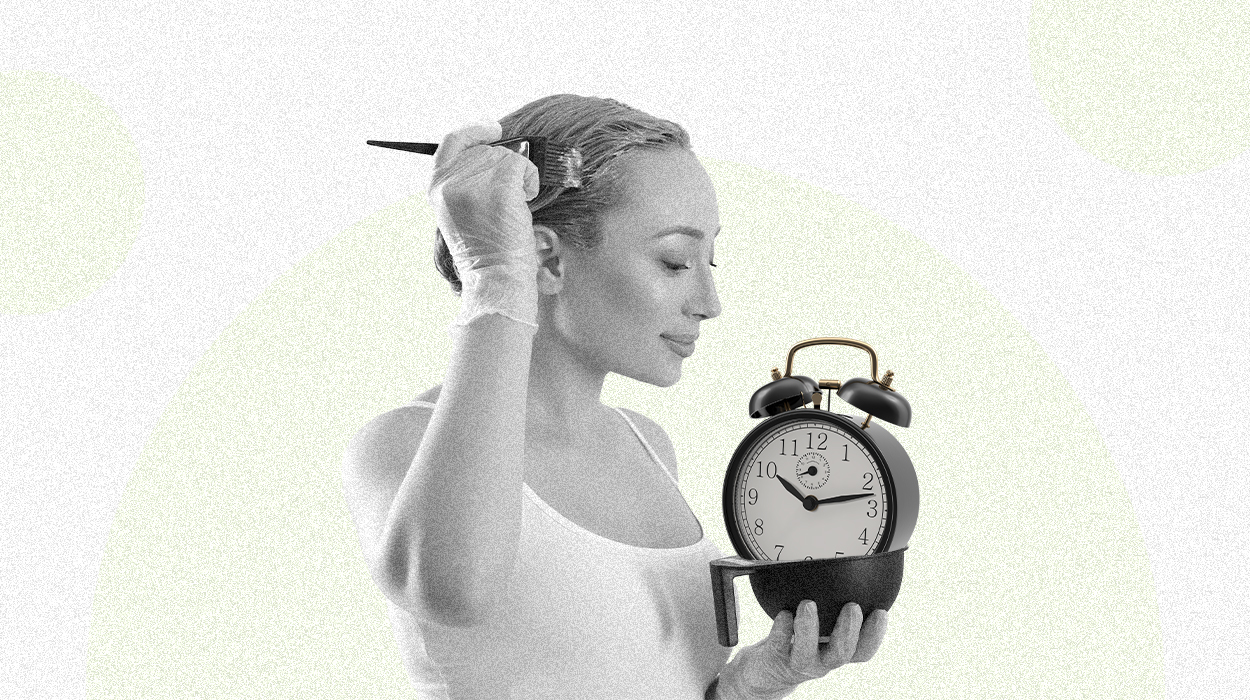How Often Can You Dye Your Hair? The Answer From Experts In 2024

“How often should I dye my hair?” is a common question among most people today. Whether you’re looking to switch up your look, cover grays, or experiment with vibrant colors, understanding the ideal frequency of hair dyeing is crucial for maintaining healthy, lustrous locks. This article will explore the factors determining how often you can dye your hair without causing damage.
From the type of dye used to the condition of your hair, we’ll explore the expert insights to help you strike the perfect balance between achieving your desired look and maintaining healthy hair. We’ll address common questions like ‘How do you dye your hair?’, ‘Can you dye your hair twice in one day?’, ‘How often can you dye your hair?’ and tips for preserving your dye throughout the process.
If you’re ready to unlock the secrets of hair dyeing frequency, let’s dive in and discover the answers from the experts.
How Often Should You Dye Your Hair?
The frequency of hair dyeing depends on various factors, including the type of dye, your hair’s condition, and desired results. Generally, it’s recommended to wait three to six weeks between dyeing sessions to minimize damage and maintain hair health. However, this can vary. Some individuals opt for touch-ups every two to three weeks, while others prefer longer intervals to allow their hair to recover. It’s crucial to prioritize proper hair care, use quality products, and consult a professional stylist who can assess your hair’s needs and guide you on the ideal dyeing frequency for your specific situation.
How Often Can You Dye Your Hair?
Temporary
How soon can you dye your hair again if you use temporary hair dyes? Well, you don’t need to wait for a specific timeframe before dyeing your hair again. These dyes typically wash out after a few shampoos or within a week or two. However, it’s still important to consider your hair growth and give it a break between dyeing sessions.
Allow at least a week or two to let your hair rest and recover before applying another temporary dye. This allows your hair to regain its natural moisture and minimize any potential hair damage. Remember to follow the instructions provided with the specific temporary hair dye product you’re using, as some may have their own recommendations for reapplication intervals.
Semi-permanent
How soon can you dye your hair after semi-permanent treatment? It’s generally recommended to wait at least one week before dyeing your hair again. Semi-temporary dye, also known as demi-permanent or semi-permanent hair dye, lasts longer than temporary dyes (about four to six weeks) but gradually fades over time.
Waiting for this duration allows your hair to recover, maintain its health, and minimize any potential damage caused by frequent dyeing. Additionally, it allows you to assess the fading and determine if you’re satisfied with the results — or if you’d like to make any adjustments in the next dyeing session.
Demi-permanent
Demi-permanent dye offers a duration of color that can last up to approximately 20 washes. It is categorized as a low-level peroxide dye and is typically recommended to be reapplied every six to eight weeks. This waiting period allows your hair to recover and gives the color pigments a chance to fade naturally, ensuring a more accurate assessment of your hair’s current shade. Doing so will also lower potential damage from excessive chemical processing.
Unlike semi-permanent hair color that simply sits on top of the hair cuticle, demi-permanent dye contains peroxide, allowing it to penetrate the hair shaft. Although it cannot lighten the hair, the peroxide in demi-permanent dye[1] enables it to deposit color effectively. As a result, demi-permanent hair color tends to last longer than semi-permanent options. Its ability to penetrate the hair shaft increases longevity, allowing the color to endure for a greater number of washes.
Permanent
Permanent hair dyes are known for their long-lasting effects.[2] If you’re wondering, “How often should I dye my hair to cover gray strands?” it’s generally considered safe to re-dye with permanent color every six to eight weeks. Unlike other types of dyes, permanent hair coloring not only adds color but also lightens the hair.
To achieve the desired results, the permanent dye should be used with a developer product. The developer assists the hair dye in penetrating the hair’s cuticle and depositing color effectively. Using permanent dye and developer together, you can achieve a vibrant and lasting color that effectively covers gray hair.
How Often Can You Bleach Your Hair?

Bleaching your hair is a chemical process that can be harsh on your strands. On average, it is generally recommended to wait at least three to six weeks between bleach sessions to allow your hair time to recover and minimize hair loss. Bleaching too frequently can lead to loss of natural oils, breakage, and weakened hair.
How often to color hair will depend on factors such as your hair’s health, texture, and the desired level of lightness. It’s essential to consult with a professional hairstylist who can assess your hair’s condition and recommend the ideal timeline for your specific needs.
How To Make Hair Dye Last Longer
Here’s a detailed explanation of how to make hair dye last longer:
Choose The Right Dye
Opt for high-quality hair dye brands with the right ingredients[3] that are known for long-lasting effects. Professional-grade dyes often have better staying power compared to drugstore brands.
Prepare Your Hair
Before dyeing, ensure your hair is clean and free from any product buildup. Use a clarifying shampoo one to two days before dyeing to remove any residue or oils hindering the dye’s penetration. However, washing just before dyeing is generally not recommended as it strips the hair of natural protective oils.
Deep Condition Before Dyeing
Moisturized hair holds color better. Apply a deep conditioning treatment[4] a day or two before dyeing to nourish and strengthen your hair.
Timing Matters
Follow the dye manufacturer’s instructions on how long to leave the color on your hair. Leaving it for too short a time may result in premature fading, while leaving it for too long could damage your hair.[5]
Use Color-Safe Products
Switch to shampoos, conditioners, and styling products specifically designed for color-treated hair. These products are formulated to be gentle and protect the color from fading.
Limit Washing
Frequent washing can strip away the color. Try to wash your hair less frequently and use dry shampoo in between washes to keep your hair fresh.
Avoid Hot Styling Tools
Heat can accelerate color fading. Minimize the use of hot styling tools like straighteners and curling irons, or use them on lower heat settings.
Shield From The Sun
UV rays can cause the color to fade. Protect your hair from the sun by wearing hats or using UV-protective sprays or leave-in conditioners when spending time outdoors.
Be Cautious With Chlorine And Saltwater
Chlorine and salt water can strip color. Protect your hair by wearing a swim cap or applying a leave-in conditioner before swimming. So how many times can you dye your hair before it falls out? Experts recommend approximately eight weeks for simple tonal changes. Prioritizing proper hair care, deep conditioning treatments, and using quality hair products are crucial to maintaining healthy and strong hair when bleaching.
Deep Condition Regularly
Moisturized hair retains color better. Incorporate deep conditioning treatments into your routine to keep your hair hydrated and healthy.
Avoid Overprocessing
Limit the use of harsh chemical treatments like bleaching or perming, as they can weaken and fade the color. Give your hair ample time to recover between such treatments.
Touch Up Roots
As your hair grows, touching up the roots promptly will help maintain a consistent color appearance and extend the life of your dye job.
Protect Your Hair At Night
When sleeping, use a satin or silk pillowcase[6] or wrap your hair in a silk scarf to minimize friction and prevent color rubbing off.
Consult A Professional
If you’re wondering, “How often can I dye my hair at home?” or you’re uncertain about maintaining your natural hair color, seek advice from a professional stylist who can provide personalized recommendations based on your hair type, color, and desired longevity.
By following these detailed tips, you can help prolong the lifespan of your hair dye and enjoy vibrant, long-lasting colors. Proper hair care and nourishment are key to maintaining healthy and vibrant hair.
The Bottom Line
You’re probably wondering, “How soon can I recolor my hair if I don’t like the color?” Well, the frequency of dyeing your hair depends on the type of dye you choose, but it’s important to give your hair a break between dye jobs. To maintain the health of your tresses, consider using color-safe products that help protect your hair’s integrity.
If you have any concerns or questions, it’s recommended to consult a professional hairstylist who can provide expert guidance and ensure your hair remains in excellent condition.
These steps will help you achieve your desired look while keeping your hair in optimal shape.
+ 6 sources
Health Canal avoids using tertiary references. We have strict sourcing guidelines and rely on peer-reviewed studies, academic researches from medical associations and institutions. To ensure the accuracy of articles in Health Canal, you can read more about the editorial process here
- Hülya Nazik, Duygun Altıntaş Aykan, Mehmet Hakan Seyithanoglu, Perihan Öztürk, Mehmet Kamil Mülayim and Hakan Nazik (2020). Evaluation of the effects of hair colouring products on the oxidative status in rats. [online] 37(5), pp.766–770. doi:https://doi.org/10.5114/ada.2020.100486.
- Zoe Diana Draelos (2022). A clinical evaluation of a permanent hair dye designed to reduce allergic contact dermatitis and hair damage. [online] 21(9), pp.3925–3928. doi:https://doi.org/10.1111/jocd.15212.
- He, L., Freideriki Michailidou, Gahlon, H.L. and Zeng, W.-B. (2022). Hair Dye Ingredients and Potential Health Risks from Exposure to Hair Dyeing. [online] 35(6), pp.901–915. doi:https://doi.org/10.1021/acs.chemrestox.1c00427.
- Paschal D’Souza and Rathi, S.K. (2015). Shampoo and conditioners: What a dermatologist should know? [online] 60(3), pp.248–248. doi:https://doi.org/10.4103/0019-5154.156355.
- Zhang, G., McMullen, R.L. and Kulcsar, L. (2016). Investigation of hair dye deposition, hair color loss, and hair damage during multiple oxidative dyeing… [online] ResearchGate. Available at: https://www.researchgate.net/publication/306230328_Investigation_of_hair_dye_deposition_hair_color_loss_and_hair_damage_during_multiple_oxidative_dyeing_and_shampooing_cycles.
- Clinicaltrials.gov. (2017). Efficacy of Silk – Like Bedding Fabric Pillow Case in the Treatment of Acne Vulgaris – Full Text View – ClinicalTrials.gov. [online] Available at: https://clinicaltrials.gov/ct2/show/NCT00767104.



